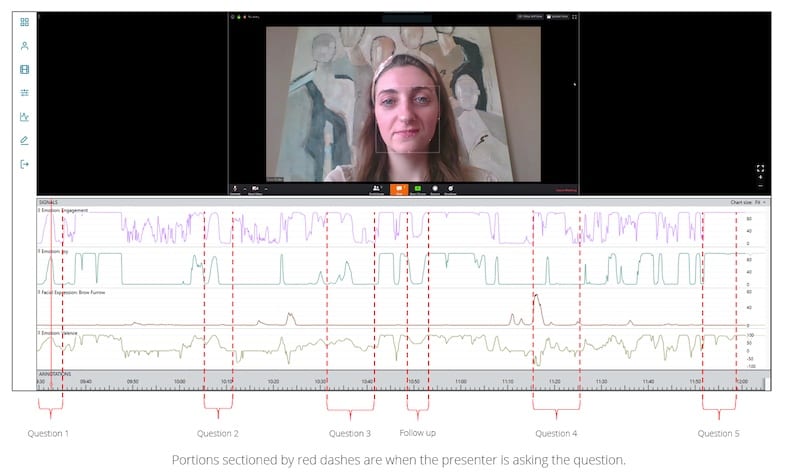Facial expressions are powerful non-verbal cues that convey emotions and intentions. Analyzing them is crucial for several reasons. Firstly, it helps in understanding people’s feelings, fostering empathy, and improving communication. Secondly, in fields like psychology, business, and security, studying facial expressions can reveal valuable insights into behavior, trustworthiness, and deception.
A big part of our communication is nonverbal. We use gestures, change the pitch of our voices, and pick up certain facial expressions to show how we feel about something. Facial expressions, in particular, speak a lot about our emotional state. In this article, we will discuss how facial expressions accurately represent someone’s emotional state and how we can apply this emotional data to business, marketing, and research.
Table of Contents
Definition of Facial Expressions
Facial expressions are part of our instinctual body language. They reveal additional, often subtle, information about the things we say — but especially about those we don’t say. Through facial expressions, we manifest our emotional states outwardly, by changing our gaze, smiling, or using other microexpressions specific to an emotion. Think about how you would typically look when you’re happy versus angry. Most likely, your facial expression when you’re in a good mood includes a wide smile, wrinkles around the eyes, raised cheeks, and lip corners raised diagonally. These expressions are important in your interactions with others because they allow people to pick up on your emotional state and respond appropriately.

Facial expressions have their origins in the evolution of the human species. They helped the organism survive by expressing imminent behaviors implied by certain emotions (e.g. running away in fear, attacking in anger) so they could avoid conflict, danger, or allow approach, and so forth. Even if some of these reactions are less needed today, facial expressions still play an essential role in how we communicate, make decisions, show empathy to others, and establish relationships.
Keep up with the latest in human behavior research and technological developments
Reading emotions on people’s faces started as early as Darwin, but Dr. Paul Ekman was one of the first researchers to study universal facial expressions. After looking at how different cultures around the world express their emotions, he concluded that there are seven basic facial expressions displayed universally:
- Anger — with corresponding facial movements such as tightened lips, rolled in lips margins, pulled down eyebrows, pulled up eyelids.
- Fear – stretched mouth, lifted eyelids, and lifted eyebrows.
- Disgust — wrinkled nose, eyebrows pulled down, lips loose, upper lip pulled up.
- Happiness — raised cheeks, raised lip corners, “crow’s feet” wrinkles around the eyes, tightened muscles around the eyes.
- Sadness — Raised inner corners of the eyes, loose eyelids, lip corners pulled down.
- Surprise — Dilated pupils, open mouth, lifted eyelids and eyebrows.
- Contempt — Neutral eyes with the lip corner pulled and stretched back on one side.
The Science Behind Facial Expressions
Facial expressions are caused by the movement of the muscles that connect to the skin and fascia in the face. A facial expression is the result of the joint activity of a network of structures that include the amygdala and multiple, interconnected cortical and subcortical motor areas. Once the person perceives a stimulus in the environment, the brain takes the input and manipulates the motor regions to create an appropriate facial expression.

The emergence of facial expression occurs through the activation of the Facial Action Coding System (FACS), which translates facial muscular positioning into basic universal emotions. In short, the FACS is an anatomically based system that breaks down facial expressions and identifies them based on muscle movements in the face. The identification of facial expressions is done through the detection of both macroexpressions (e.g. “obvious” expressions that last between 1/2 a second to 4 seconds) and microexpressions (e.g. involuntary facial expressions that occur within a fraction of a second). Although they are subtler than an ‘obvious’ emotion, micro-expressions help us communicate our internal world to others, even when we don’t speak the same language as the other person. They are brief, involuntary, and occur even when we try to conceal our feelings. For example, you could notice a small frown on someone’s face in the airport, which will automatically lead your facial detection system to interpret that as a sign of annoyance in the other person. Thanks to microexpressions, the person in front of you does not need to make a full display of their emotional state for you to pick up on it.
If you would like to see all of these different FACS iMotions has made a comprehensive library of what each facial action unit looks like, which you can find here:
Benefits of Understanding Facial Expressions
Since the face is the best window into people’s emotional lives, understanding facial expressions helps us better understand each other. Here are some research-backed benefits.
Enhanced communication skills
When we listen to someone in person, we don’t just pay attention to the words they say. We also look at the expressions accompanying their words. With this additional information, we can tell if the other person is honest, if they are personally and emotionally affected by what they’re saying, or if they’re entirely detached from the story. Reading facial expressions leads to better communication because it adds meaning to the speaker’s words. As a result, we can respond in a manner more suitable to the person in front of us.
Building rapport and empathy
If someone tells a story and their facial expression indicates a strong emotion of fear and dread, we would not remain impassive and indifferent. We would probably adjust our own facial expressions and words, too. This helps the other person feel understood and met with care and empathy. Therefore, reading facial expressions is a core component of effective rapport-building with someone else.
Profiling and deception detection
When we lie, our face involuntarily displays two different messages — the one we want to show and the one we try to conceal. But our microexpressions often give away more information than we intend to. Through facial expressions, we can better detect when someone lies or hides something from us. This is particularly useful in settings where deception detection is essential.
Using iMotions for Facial Expression Analysis
iMotions integrates various facial expression detection technologies, along with its eye tracker software, that offer insights into the emotions displayed in settings like research, marketing, and customer service.

Live synchronization of expressed facial emotions with stimuli
The iMotions software captures the facial expressions triggered stimuli in real-time, leading to accurate emotion detection. When detecting emotions on the face, it is important that they are synced with the presented stimuli, so that a clear correlation can be established between stimulus and reaction. If the synchronization is even a bit off, the data will be all but useless.
Importing recorded facial videos for analysis
The iMotions Facial Expression Analysis Module allows you to detect emotions from recorded videos. You simply do that by importing the video into the iMotions software and then you carry out the analysis directly from the imported material.
Collecting fEMG data for analysis
To collect facial electromyography (fEMG) data with iMotions Lab, you need to use the iMotions EMG Module, which integrates with multiple EMG devices from BIOPAC, Shimmer and Plux Biosignals. These electrodes will record the electrical activity generated by muscle contractions. The iMotions software connects, records, and visualizes this data in real-time, allowing for a comprehensive analysis of muscle movements and their association with emotions and behavioral outcomes.
Built-in analysis and visualization tools
Facial expression detection is only the first step in gaining insights into someone’s emotions. You also need to analyze and interpret the collected data to reach the desired results. iMotions offers software solutions that help you analyze the collected data and receive a visualization output such as representation of facial expressions, emotion labels, or visualizations of emotion probabilities.
Exporting data for additional analyses
iMotions software also allows you to export the data once it has been analyzed. If you need to carry out additional tests to check for accuracy and synchronization, you can export the output and run it once again through an additional analysis.
Conclusion
Making assumptions about someone without looking at their facial expression of emotion is insufficient. If words can only reveal so much, emotions are more difficult to conceal and lie about. For this reason, technologies aimed at detecting facial emotion will paint a fuller picture of someone’s internal world. They reveal real-time reactions to stimuli and say a lot about their preferences, needs, and decision-making processes.
If you are interested in Facial Expressions and their analysis, here are a list of articles you can read on the subject:
















